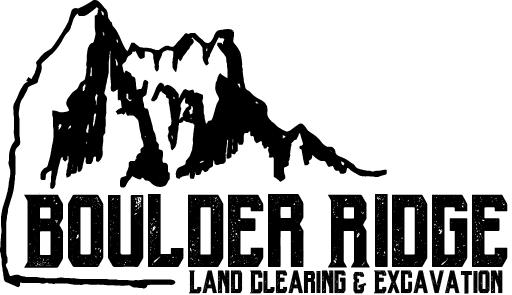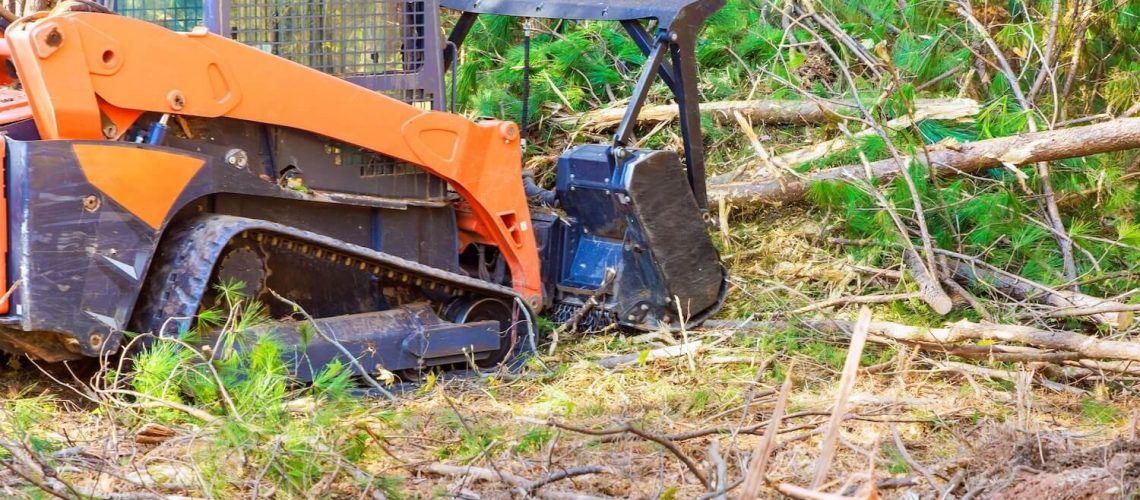When managing overgrown land or preparing a property for new uses, property owners often face a crucial decision: brush mulching or traditional clearing? Both methods have unique benefits and drawbacks, and the choice can significantly affect the outcome of your land management project. This comprehensive guide will explore the nuances of brush mulching and traditional clearing, delve into the advantages and disadvantages of each, and provide insights into why brush mulching services might be the superior choice for many property owners.
Understanding Brush Mulching
Brush mulching is a modern land management technique that uses specialized equipment to grind down brush, small trees, and other vegetation into small, manageable pieces. The resulting mulch is spread over the ground, providing a protective layer that enhances soil health and reduces erosion.
Advantages of Brush Mulching
- Erosion Control: One of the primary benefits of brush mulching is its ability to control soil erosion. The mulch created during the process acts as a barrier that prevents water runoff, which can wash away topsoil and lead to erosion. This is particularly valuable on slopes or areas prone to heavy rainfall.
- Nutrient Enrichment: As the mulch decomposes, it enriches the soil with organic matter and essential nutrients. This can improve soil fertility and promote healthier plant growth. Over time, the mulch contributes to a richer, more productive soil ecosystem.
- Reduced Need for Hauling: Traditional clearing often requires the removal of debris, which involves additional labor and costs. With brush mulching, the debris is ground into mulch and left on-site, reducing the need for hauling and disposal. This not only saves money but also minimizes the environmental impact of transporting waste.
- Minimized Soil Disturbance: Brush mulching causes less disruption to the soil compared to traditional clearing methods. Heavy machinery used in traditional clearing can compact soil and damage existing plant roots, while mulching machines are designed to work with minimal disturbance.
- Cost-Effective: Although brush mulching may require a higher initial investment in equipment and services, it can be more cost-effective in the long run. Savings on debris removal and reduced erosion-related costs can offset the initial expenditure.
- Enhanced Aesthetic Appeal: The layer of mulch left behind can enhance the visual appeal of your property. It provides a uniform appearance and can help to suppress weeds, giving the land a well-maintained look.
Disadvantages of Brush Mulching
- Not Ideal for All Vegetation: Brush mulching is most effective for managing smaller brush, saplings, and undergrowth. Large trees or extremely dense vegetation may not be suitable for this method, as the equipment may struggle to process such materials.
- Potential for Mulch Build-Up: If not managed correctly, the accumulation of mulch can create a thick layer that may inhibit the growth of other plants. Regular monitoring and maintenance are necessary to prevent excessive mulch build-up.
- Maintenance Required: The equipment used in brush mulching requires regular maintenance to ensure optimal performance. This can be costly and time-consuming, particularly for property owners who opt to manage the equipment themselves.
Understanding Traditional Forestry Clearing
Traditional clearing methods involve the removal of vegetation and debris through manual or mechanical means. This process typically includes cutting down trees, removing stumps, and clearing brush, often followed by hauling away the debris.
Advantages of Traditional Clearing Services
- Effective for Dense Areas: Traditional clearing is highly effective for managing dense vegetation and large trees. It can handle a variety of vegetation types and is particularly useful for areas where brush mulching may not be feasible.
- Immediate Land Use: Once the land has been cleared, it is generally ready for immediate use. There’s no need to wait for mulch to decompose or settle, making it a suitable choice for projects with tight timelines.
- Versatility: Traditional clearing methods are versatile and can be adapted to various types of vegetation and land conditions. This flexibility makes it a reliable option for different land management needs.
- Site Preparation: For construction or landscaping projects, traditional clearing provides a clean slate. Removing all vegetation and debris creates a blank canvas for new developments, ensuring that the site is ready for subsequent work.
Disadvantages of Traditional Clearing Services
- Higher Costs: Traditional clearing can be more expensive due to the need for additional labor, machinery, and disposal of debris. Hauling away waste adds to the overall cost, making it a less budget-friendly option.
- Erosion Risks: Removing vegetation can leave the soil exposed, increasing the risk of erosion. Additional measures, such as erosion control mats or seeding, may be required to prevent soil loss.
- Soil Disruption: Heavy machinery used in traditional clearing can disrupt the soil structure, leading to compaction and affecting soil health. This can impact future plant growth and require remedial measures.
- Environmental Impact: Traditional clearing methods can have a greater environmental impact. The use of chemicals and heavy equipment may disrupt local ecosystems and wildlife habitats, raising concerns about sustainability.
Brush Mulching Services: A Superior Clearing Choice for Many Property Owners
For many property owners, opting for professional brush mulching services can provide a range of benefits that make it a more attractive choice than traditional clearing methods. These services are designed to handle various vegetation types efficiently while minimizing environmental impact.
Benefits of Professional Brush Mulching Services
- Expertise and Efficiency: Professional brush mulching services bring a wealth of experience and expertise to the table. Trained operators understand how to handle different types of vegetation and can efficiently execute mulching projects of all sizes. Their knowledge ensures that the job is done correctly, reducing the risk of issues and delays.
- State-of-the-Art Equipment: Professional services use advanced mulching equipment that is specifically designed for handling a wide range of vegetation. Modern machines are more efficient and effective, capable of processing large volumes of brush quickly and accurately. This high-quality equipment ensures a superior finish and optimal results.
- Reduced Environmental Impact: Reputable brush mulching companies are committed to minimizing their environmental footprint. They use techniques that reduce soil disturbance and avoid practices that could harm local ecosystems. By choosing professional services, you support environmentally responsible land management practices.
- Time and Cost Savings: Engaging a professional brush mulching service can save you time and money. The efficiency of experienced operators and advanced equipment means the job is completed more quickly than DIY methods. Additionally, the reduced need for debris removal lowers overall costs, making it a cost-effective option.
- Ongoing Support and Maintenance: Many brush mulching service providers offer additional support and maintenance services. This ongoing support ensures that your property remains in good condition after the initial work is completed. Whether it’s periodic mulching or advice on land management, professional services provide valuable resources to keep your property healthy.
Finding the Right Brush Mulching Service
Selecting the right brush mulching service is crucial for achieving the best results. Here are some tips for finding a reputable quality provider:
- Research and Reviews: Start by researching local brush mulching services and reading customer reviews. Positive feedback from previous clients can provide insights into the quality of service and reliability of the company.
- Experience and Expertise: Look for companies with extensive experience in brush mulching. An established provider with a track record of successful projects is more likely to deliver high-quality results.
- Equipment Quality: Inquire about the equipment used by the service provider. Modern, well-maintained machinery ensures efficient and effective mulching, leading to better outcomes for your property.
- Get Multiple Quotes: Request quotes from several brush mulching services to compare pricing and services offered. This will help you make an informed decision and ensure that you get the best value for your investment.
- Check Certifications and Licenses: Ensure that the company holds the necessary certifications and licenses for brush mulching. This guarantees that they adhere to industry standards and regulations, providing peace of mind that the work will be done professionally.
Factors to Consider When Choosing Quality Clearing Method
- Type of Vegetation: Evaluate the type of vegetation on your property. Brush mulching is ideal for smaller brush and undergrowth, while traditional clearing is better suited for large trees and dense areas.
- Soil Health: Consider the impact on soil health. Brush mulching can enhance soil quality and prevent erosion, whereas traditional clearing may require additional measures to address soil degradation.
- Budget: Assess your budget for the project. Brush mulching may involve a higher upfront cost but offers long-term savings on debris removal and erosion control. Traditional clearing might have lower initial costs but could lead to additional expenses for waste disposal and erosion management.
- Land Use Goals: Determine your goals for the land. If you need a quick, clean area for construction or landscaping, traditional clearing may be preferable. If you’re seeking a more sustainable approach with benefits for soil health, brush mulching is a strong option.
- Environmental Impact: Evaluate the environmental impact of each method. Brush mulching tends to be more eco-friendly, while traditional clearing may have a greater impact on local ecosystems.
- Regulations and Permits: Check local regulations and permits required for land clearing. Some areas have specific guidelines or restrictions that may influence your choice of method.
Making the Land Clearing Decision
Ultimately, the decision between brush mulching and traditional clearing depends on your specific needs and circumstances. Here’s a concise guide to help you decide:
- Choose Brush Mulching If:
- You’re dealing with smaller brush and undergrowth.
- You want to improve soil health and reduce erosion.
- You prefer a more sustainable and cost-effective option in the long run.
- You’re managing a large area with minimal soil disturbance.
- You value the expertise and efficiency offered by professional brush mulching services.
- Choose Traditional Clearing If:
- You need to remove large trees or dense vegetation.
- You require immediate land use with minimal waiting time.
- You have a larger budget and can manage debris disposal and erosion control.
- You’re preparing the land for significant construction or landscaping projects.
Brush Mulching and Traditional Land Clearing Conclusion
Choosing between brush mulching and traditional clearing is a critical decision that depends on various factors including the type of vegetation, soil health, budget, and land use goals. Brush mulching offers a sustainable approach with benefits for soil health and erosion control, and professional brush mulching services can enhance these advantages by providing expertise, modern equipment, and ongoing support. Traditional clearing provides immediate results and versatility but may come with higher costs and environmental concerns.
By carefully evaluating your property’s needs and considering the benefits of each method, you can make an informed decision that aligns with your goals. Opting for brush mulching and professional services may offer the long-term benefits of improved soil health, reduced erosion, and cost savings, making it a compelling choice for many property owners.

